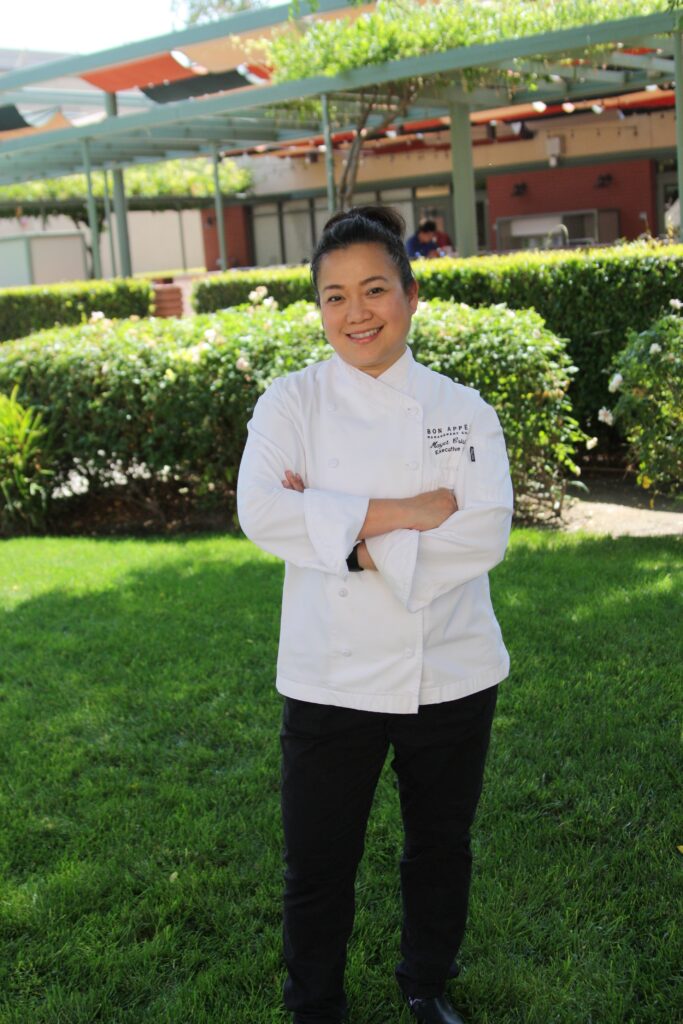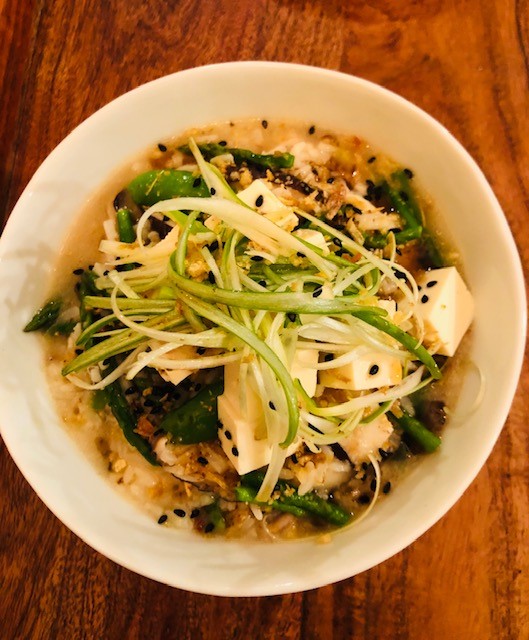Plant-Forward Influencer: Executive Chef Mayet Cristobal
- by bonappetit
During National Nutrition Month, we’re profiling chefs and Registered Dietitians who are plant-forward influencers at Bon Appétit. These dynamic individuals are demonstrating how to make plant-forward eating as delicious as it is good for you. Each has a story that shaped their personal and professional journeys toward plant-forward eating.
 I am quite fortunate to work for a company that truly believes we have the opportunity and responsibility to make this place a better world through sustainable food practices. I have been a part of the Bon Appétit team for 20+ years but have lived the “Farm to Fork” principle almost all my life. As I recall my childhood in the Philippines, I am reminded of how my grandmother cooked for us every day. She went to the market daily and bought fish and other seafood that was so fresh they were still swimming in their bags when she got home. She only cooked vegetables that were in season: corn, tomatoes, radishes, long beans, and eggplant in the summer…hard squashes in the winter or during the colder months, when the temperature actually got below 85 degrees. Vegetables were a huge part of our meals…often simply steamed and paired with fermented shrimp paste or fish sauce. When I had a break from running around the melon or rice fields, I would hang out in the kitchen and help her cook. I was her sous chef. Those days were some of the best days of my childhood.
I am quite fortunate to work for a company that truly believes we have the opportunity and responsibility to make this place a better world through sustainable food practices. I have been a part of the Bon Appétit team for 20+ years but have lived the “Farm to Fork” principle almost all my life. As I recall my childhood in the Philippines, I am reminded of how my grandmother cooked for us every day. She went to the market daily and bought fish and other seafood that was so fresh they were still swimming in their bags when she got home. She only cooked vegetables that were in season: corn, tomatoes, radishes, long beans, and eggplant in the summer…hard squashes in the winter or during the colder months, when the temperature actually got below 85 degrees. Vegetables were a huge part of our meals…often simply steamed and paired with fermented shrimp paste or fish sauce. When I had a break from running around the melon or rice fields, I would hang out in the kitchen and help her cook. I was her sous chef. Those days were some of the best days of my childhood.
That story sounds prehistoric and it might as well be for my 12-year-old son who is growing up in a city like Los Angeles. The story may sound ancient and foreign, but its meaning is never outdated…“nourish the community, buy local as much as possible, waste not, eat healthy, and replenish our shared natural resources for future generations.” My son may never run around in a rice field, plant his own vegetables, or gut his own fish for dinner, but I am thankful to know that there are companies like Bon Appétit that are invested in the preservation of our environment. Whether it is through the sustainable food movement, promoting and practicing a Low Carbon Lifestyle, food waste management, educating people about a plant-based diet, or advocating for nutrition and health, the company makes huge efforts to ensure that the next generation may experience our present and possibly look into our past.
Food evolution happens every day. Technology provides us with information on what’s new and best in eating in the world. We don’t even have to travel anymore to find out what’s the latest food trend in Asia, South America, and Europe. We live in a world where the processes for perfectly poached eggs, sourdough starters, and basic pasta making can be found on YouTube channels…all accessible through our smart phones. Technology has also provided us with food delivered to our doors in minutes. Nothing we crave is impossible to get.
Just a few years ago, the term “root-to-stem” was a new thing in food service to promote waste management (although this practice has been around in many cultures with food insecurity). Cricket protein is also now widely used in many communities. Fermented foods such as yogurt, kimchi, sauerkraut, kombucha, and miso started showing up on our plates to promote natural probiotics, which are good for our immune system. Middle Eastern cuisine and Filipino cuisine have hit the mainstream market. We are aware. We are informed. Our palate has expanded.
The food industry’s hot new buzzwords are plant-based and plant-forward. And it is a cool thing. The goal is to make sure that even non-vegetarians enjoy meals made mostly or even entirely of plants. While we have a companywide initiative for plant-forward cooking, more and more our guests and my culinary teams are getting interested in entirely plant-based meals. We prepare our plant-based dishes using seasonal ingredients and plant-based proteins and apply different cooking techniques. Many of the plant-based dishes I have created at home and at work are re-invention of my favorites with the meat protein replaced with vegetables. Don’t be surprised to see a BBQ pulled mushroom or jackfruit sandwich or buffalo cauliflower on our menu. I have even made Impossible embutido (Filipino-style meatloaf) at work that received raves!
March is National Nutrition Month and Women’s History Month, which makes it the perfect time to highlight a dish my grandmother used to make for us when we were kids. It is a dish of rice porridge known as lugaw in the Filipino culture or congee in Chinese. Her version called for poached chicken, chicken stock, egg, vegetables and often topped with pork rinds or crispy fried pork belly. This dish always made me feel loved when I ate it as a child. It is also quite filling and satisfying. My version is vegan and made without gluten. The stock is made out of mushroom stems, leeks, and ginger. Now that the bleak California winter has passed and that spring is almost here, I am happy to see the beautiful and local spring vegetables added to my porridge recipe. Sweet peas, asparagus, scallions, leeks, carrots!
This recipe is plant-based, sustainable, healthy, and includes a little bit of my Filipino heritage. Just like my grandmother’s hugs made me feel this porridge will fill you up with warmth and comfort.

Executive Chef Mayet Cristobal’s congee, known as lugaw in the Filipino culture, is a comforting memory of a favorite dish from her childhood. Inspired her grandmother’s recipe, Mayet combines aromatic leeks and ginger with earthy mushrooms for a satisfying plant-based version of the dish.
Mushroom, Leeks, and Ginger Congee
Typically served for breakfast or dim sum, congee is an Asian comfort food that’s easy to prepare and can be embellished with tofu and sesame seeds for a well-rounded plant-based meal.
Makes 4-6 servings
Homemade mushroom stock
- 2 cups mushroom stems
- 1 inch ginger, peeled
- 1 medium onion, quartered
- 1 leek, washed well, chopped large
- 2 cloves of garlic
- Fresh thyme and parsley sprigs
- 2 quarts of water
Lugaw/Congee
- 1 tablespoon canola oil
- 1/2 cup yellow onions, chopped
- 3 cloves garlic, minced
- 1 tablespoon ginger, peeled and finely chopped
- 1 cup leeks, finely chopped, white parts only
- 1 cup carrots, sliced
- 2 cups shiitake mushrooms, sliced
- 2 cups short-grain rice
- 1 – 1-1/2 quarts mushroom stock
- 1 bunch of asparagus, cut into 1-inch pieces
- 1/2 cup sweet peas
- 1/2 bunch spinach
- Salt and pepper to taste
To make stock, bring all ingredients to a boil then simmer for 20 minutes. Strain and set aside.
Heat oil in a 4-quart stock pan over medium heat. Add onion and sauté for 1 minute. Add garlic and ginger sautéing until just fragrant. Add the leeks, carrots, and mushrooms and cook for about 1 minute. Add rice and stir for an additional minute to coat the rice with oil.
Add 1 quart of mushroom stock to the rice. Bring to a slow boil and stir to make sure that the rice is not stuck to the pan. Reduce heat to low, cover the pot, and simmer until the rice is cooked. Check every five minutes and add stock as needed to ensure there is plenty of broth and rice is not sticking to the pan.
Once rice is fully cooked, add asparagus, peas, and spinach. Turn off heat and season with salt and pepper. Serve hot in a bowl.
Optional: top congee with scallions and tofu then garnish with sesame seeds and a drizzle of sesame oil.